This Homemade Achard Masala Paste Recipe, also known as achard spice mix, can be used for both achard and vindaye. Mauritians love vegetable achard and it goes on almost everything. I am not exaggerating here. While packets of pre-mixed achard spices can conveniently be purchased at any grocery store in Mauritius, they do not come close to achard masala paste made from scratch. This recipe uses primarily whole spices with the addition of some fresh curry leaves. It needs a little bit of elbow grease but, with the tips and tricks I have included, it is easy to make and freezes well for months to come. So it makes it all worth the effort.

Jump to:
What is achard masala paste?
To learn more about the Mauritian achard, we need to dig into its origin: the Indian achar or achaar. In Hindi, achar means “pickle.” An Indian pickle is different from what is known in the West as a pickle. More on this shortly. In Mauritius, the name for achar is “achard,” which has a bit of a French twist to it, or even “zasar”, which would be in our Mauritian Créole. On this blog, we will refer to Mauritian achar as achard and the original Indian achar as achar.
The Indian achar has become a catch-all term for pickle, a must-have popular condiment in Indian cuisine or its derivative. Achar in the North of India is typically made with mustard oil, while the South Indian style is made with sesame oil. Vegetable oil is also very commonly used along with vinegar. The spices that can be found in all achar versions are mustard seeds, turmeric and red chili powder. Other spices commonly found in achars are: fenugreek seeds, fennel seeds and nigella seeds.
Mauritian achard is not the same as a true Indian achar. Indian achar is only used as a condiment and sparingly, as they are usually very sour and quite salty. Ours went through an island evolution that makes it uniquely Mauritian and the best way to think of it is kind of part pickle, part side dish, and it can sometimes be its own meal. The most common type of achard in Mauritius is cabbage or vegetable achard. It is a lunchtime favorite amongst the locals and is usually served in a fresh baguette. Mauritians have perfected the art of eating meals with turmeric in a white dress shirt.
This achard masala paste is perfect to make any variety of Mauritian achard your heart desires! It is the base for all achards. Check out our Mauritian Vegetable Achard Recipe (coming in August 2023) that makes use of this paste, and to read a little more about this beloved dish. Vindaye is another Mauritian favorite and it is basically the meat version of the Mauritian vegetable achard. This achard spice paste is great for both achard and vindaye recipes.
My version
I present to you the achard masala paste that my grandma taught me and still uses to this day. We used to live in a small village called Mount, in the district of Pamplemousses, located in the northwest of the island. She learned it from Indo-Mauritians who showed her the traditional way of making it on a roche cari using whole spices along. Roche cari is basically a badass mortar and pestle that is more a slab of polished rock than a bowl, and it comes with a smaller polished rock.
My grandma is also an excellent cook and I have not had an achard or vindaye that beats hers. I believe this paste is her secret ingredient.
Reasons to love this recipe
- Easy: With nifty tips and tricks on how to handle the whole spices, this recipe is easy to execute.
- Simple pantry ingredients: You probably have all the spices in your pantry already. Read the Ingredients Notes Section below if you do not have whole dried turmeric root for this recipe.
- Freezes well: It freezes well and lasts for several months. You can make a big batch and freeze some for later.
- Two in one: Achar and vindaye use the same masala. It is like prepping for two dishes at once, especially if you decide to double and freeze the paste.
- Vegan: This recipe does not contain any animal product.
- Best-tasting achard: Using this paste will result in the best-tasting achard and vindaye because of the selection of ingredients in this recipe and the use of whole spices.
Recipe ingredients
You’ll need the following ingredients to make this Homemade Achard Masala Paste Recipe:
- Dried whole turmeric (turmeric fingers)
- Brown mustard seeds (or black)
- Dried red chilis
- Dried fenugreek leaves (kasoori methi)
- Fenugreek seeds (methi)
- curry leaves fresh or dried, optional
- 1 cup water
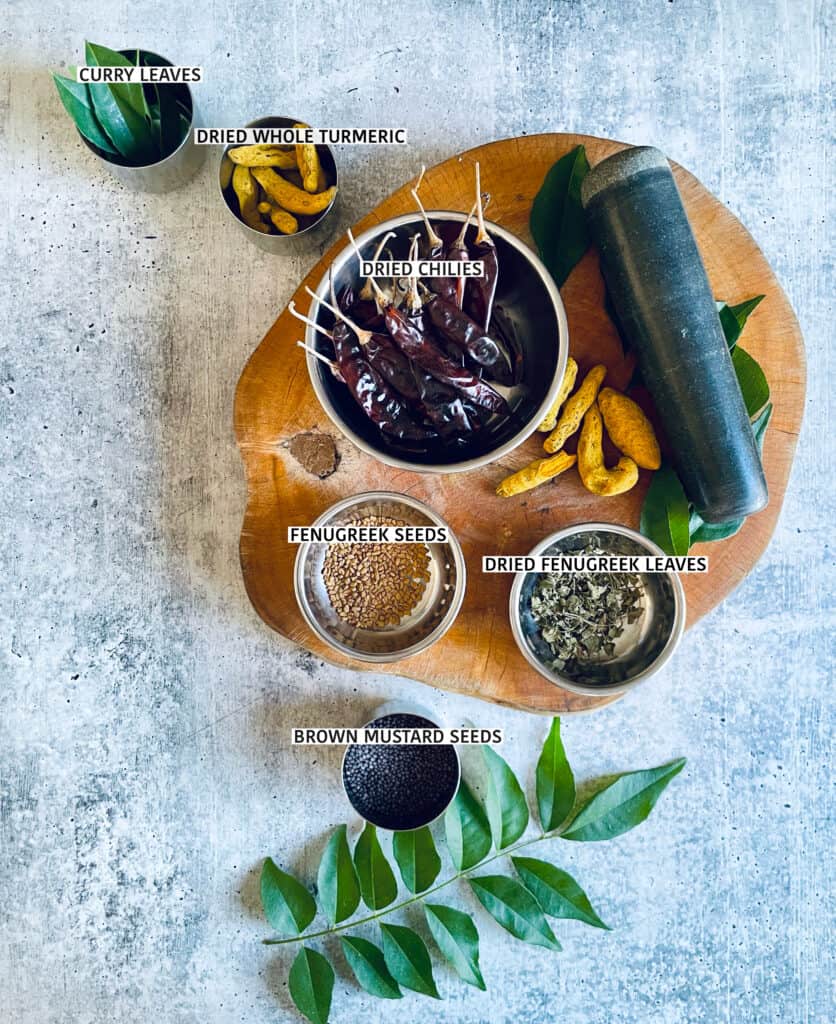
Ingredients, additions and swaps
- Whole dried turmeric root: You might not have whole dried turmeric root, also called turmeric fingers, at home. As I think the recipe tastes much better if using turmeric in that form, it is best not to substitute. But in a pinch, you can use turmeric powder.
- Fenugreek seeds and whole mustard seeds: As with the turmeric fingers, I recommend using fenugreek seeds and mustard seeds for this recipe unless you have high-quality powdered versions at home.
- Dried red chilies: You will probably get great results with most Indian dried red chilies. The ones that I prefer to use are the ones that are medium-sized, slender and smoothed skin like Guntur Sannam or even Kashmiri. If you love real heat and are in North America, you can use dried chili de arbol.
I do not recommend swapping any ingredient in this recipe. If you so desire, you could add some garlic, omit the curry leaves, or adjust the amount of the different spices. Do try to make it the way it is presented first, and you can modify future recipes.
Quick step-by-step
Here are some quick visual instructions. Complete instructions with exact ingredients will be in the recipe card below!
STEP 1: In a small saucepan, gently boil the turmeric roots in a small saucepan. If you prefer you can soak the turmeric roots for a few hours instead, at least 2 hours. Then drain. Reserve the turmeric water.
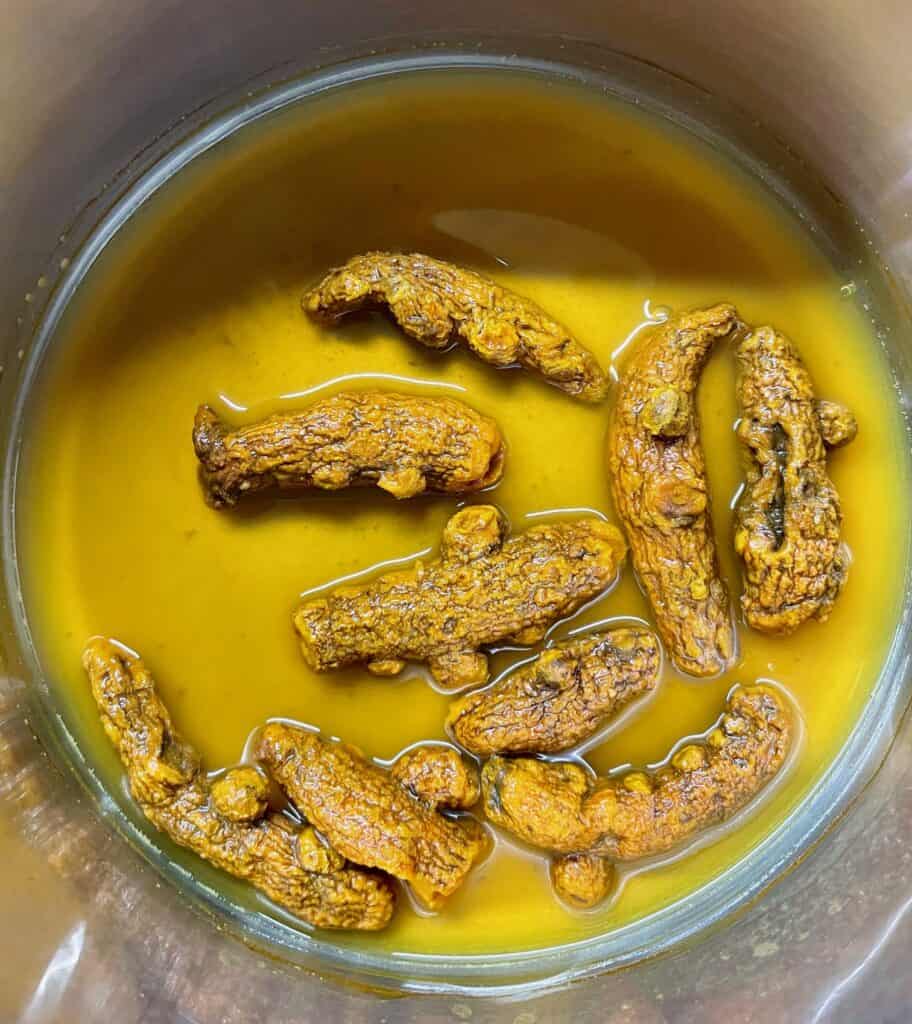
STEP 2: Transfer the soaked turmeric roots and pound until they break into smaller pieces.
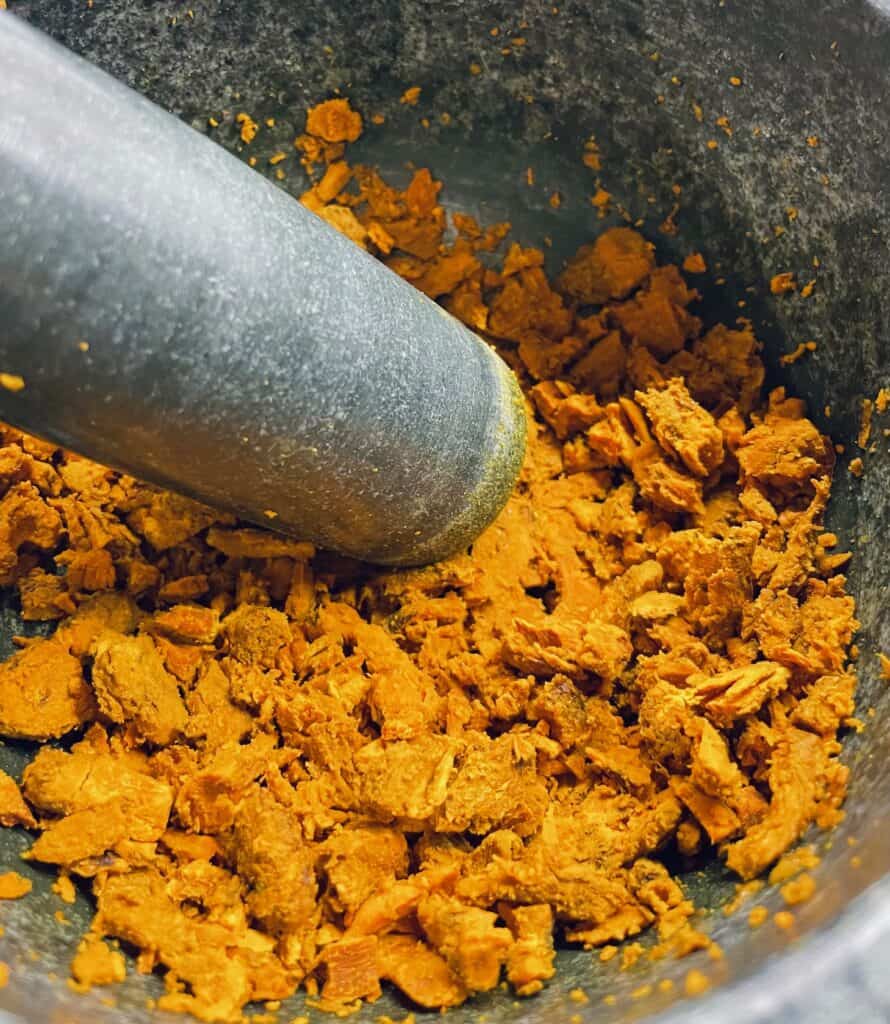
STEP 3: Transfer the pounded turmeric roots, along with the rest of the spices into a high-powered blender (I used Vitamix). Then add the reserved turmeric water along with some additional water to the blender, about 1 cup of water, you might a little more to blend the paste easily. Blend until a paste is formed. The paste can be a little coarse as in the picture and does not need to be perfectly smooth unless you prefer it that way.
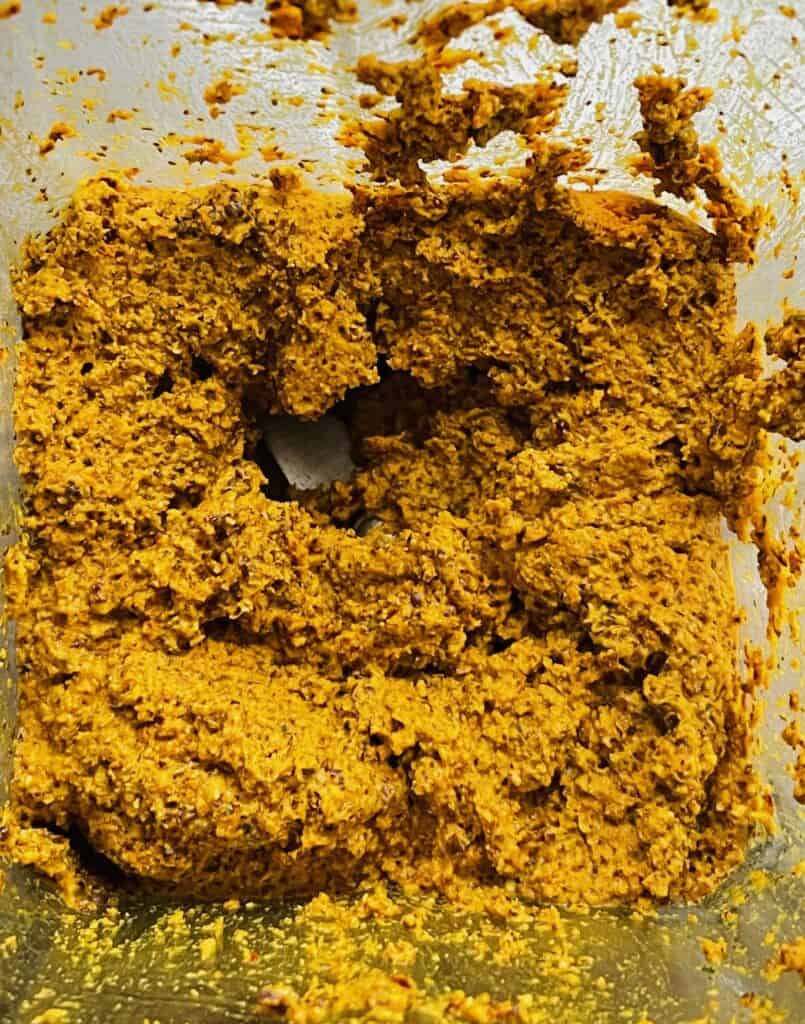
STEP 4: Transfer into jars, preferably sterilized ones, if you intend to keep them in the fridge for a few months. Any type of container should be fine.

Storage
Storing in Fridge
You can store the paste in a sterilized jar in the fridge for several months. Top it with vegetable oil if you want it to keep for longer. Do not use olive oil as it will impart a flavor. Use a neutral oil or mustard oil.
Storing in Freezer
Method 1
Per Serving Size Used in a Whole Recipe
If you are not planning on making achard or vindaye often, you can roll the masala paste into balls (each ball will be the amount you will use per recipe) and freeze them. This way, you can defrost them one by one, as needed, per recipe.
Method 2 (My Preferred Method)
I love to freeze them in 8 oz mason jars. This method is more practical than the one above and is better if you are planning on cooking achar or vindaye more frequently than once a month. This is what we do in Mauritius, although in Mauritius we tend to use old yogurt containers 😊.
Thawing
Transfer the masala ball or jar of masala to the fridge. Both defrost quite quickly, a matter of hours for the former and overnight for the latter unless it is a huge jar!
Frequently Asked Questions
Yes, you will need a mortar and pestle, and a high-powered blender like Vitamix or Ninja.
I found that if I hand wash my blender with warm water, the blender does not stain.
If your pantry is pretty stocked, you might have all the ingredients in this recipe. Depending on where you are in the world, you can find most of these on Amazon.com or at your local Indian grocery store. You can also find select ingredients in my US online shop Poisson Salé. Click here for other sourcing options.
Mustard oil is not essential but I do feel like it makes the recipe special and gives it an authentic touch. Do not use olive oil as it will impart a flavor. The best substitute for it is a neutral vegetable oil.
I would say it is low to medium spicy. You can increase or decrease the number of dried red chilies as needed. If you want to increase the heat level use dried chili de arbol if available where you are.
You can find a glossary and ingredient translations here.
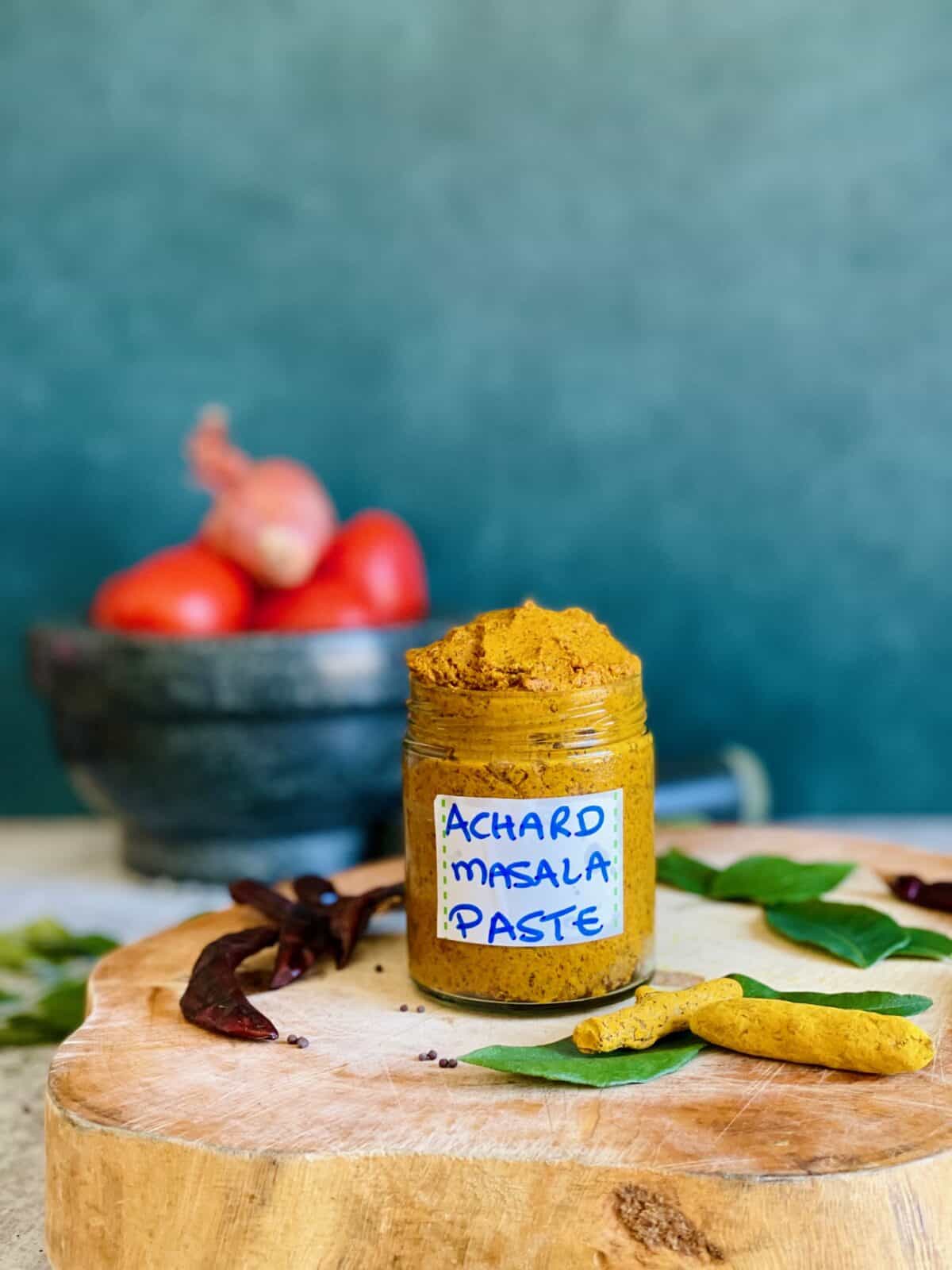
Homemade Achard Masala Paste Recipe (For Achard & Vindaye)
Equipment
- 1 Mortar and pestle (I use a medium-sized stone one)
- 1 High-powdered blender (I use Vitamix)
Ingredients
- 10 whole dried turmeric roots 1.6 oz, 45 g
- 5 tablespoons brown mustard seeds 1/3 cup, 48 g
- 15-18 dried red chilies deseeded and roughly hand-torn
- 2 teaspoons dried fenugreek leaves kasoori methi
- 1 teaspoon fenugreek seeds methi, 0.16 oz, 4.6 g
- 6 curry leaves fresh or dried, optional
- 1 cup water
Instructions
- Gently boil turmeric. Transfer the whole dried turmeric roots into a small saucepan with enough water to cover. Bring to a boil and gently boil until turmeric roots soften, 10 minutes. Drain turmeric roots and reserve the leftover turmeric water. You will need the turmeric water to blend the spices later.
- Transfer the boiled turmeric roots to a mortar and pestle and pound until broken down into 1-centimeter pieces. The pieces do not have to be tiny as they will go into a blender. However, they will have to be small enough to blend with the rest of the ingredients easily and evenly.
- Transfer the turmeric pieces along with the rest of the ingredients (except water) into the blender. Add reserved turmeric water and enough additional water to the blender. You will need about 1 cup of water total, or up to a half cup more to make a paste. Blend a few times until a paste is formed. The paste can be a bit coarse but you can blend it until completely smooth if preferred. I prefer it coarse as it adds texture and character to the achard or vindaye.
- Transfer into containers or jars. I prefer to use sterilized mason jars. Allow the paste to completely cool down before transferring the jars to the fridge or freezer. The paste will keep for a few weeks in the fridge and around 6 months in the freezer.
Sharing is caring
If you enjoyed reading this post or have made the recipe, please share it with your loved ones. You can also leave me a comment below!


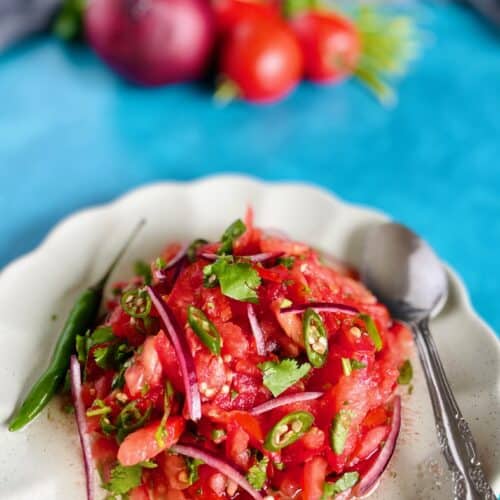


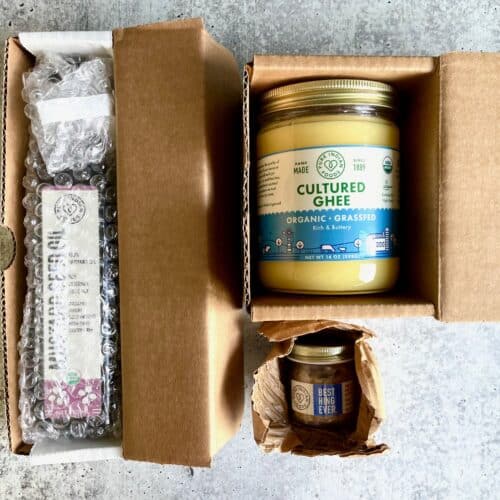
Leave a Reply